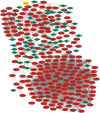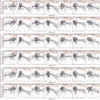Identification of potential core genes in esophageal carcinoma using bioinformatics analysis
- PMID: 34232175
- PMCID: PMC8270608
- DOI: 10.1097/MD.0000000000026428
Identification of potential core genes in esophageal carcinoma using bioinformatics analysis
Abstract
Background: Esophageal squamous cell carcinoma (ESCC) is a common human malignancy worldwide. The tumorigenesis mechanism in ESCC is unclear.
Materials and methods: To explore potential therapeutic targets for ESCC, we analyzed 3 microarray datasets (GSE20347, GSE38129, and GSE67269) derived from the gene expression omnibus (GEO) database. Then, the GEO2R tool was used to screen out differently expressed genes (DEGs) between ESCC and normal tissue. Gene ontology function and kyoto encyclopedia of genes and genomes pathway enrichment analysis were performed using the database for annotation, visualization and integrated discovery to identify the pathways and functional annotation of DEGs. Protein-protein interaction of these DEGs was analyzed based on the search tool for the retrieval of interacting genes database and visualized by Cytoscape software. In addition, we used encyclopedia of RNA interactomes (ENCORI), gene expression profiling interactive analysis (GEPIA), and the human protein atlas to confirm the expression of hub genes in ESCC. Finally, GEPIA was used to evaluate the prognostic value of hub genes expression in ESCC patients and we estimated the associations between hub genes expression and immune cell populations (B Cell, CD8+ T Cell, CD4+ T Cell, Macrophage, Neutrophil, and Dendritic Cell) in esophageal carcinoma (ESCA) using tumor immune estimation resource (TIMER).
Results: In this study, 707 DEGs (including 385 upregulated genes and 322 downregulated genes) and 6 hub genes (cyclin B1 [CCNB1], cyclin dependent kinase 1 [CDK1], aurora kinase A [AURKA], ubiquitin conjugating enzyme E2C [UBE2C], cyclin A2 [CCNA2], and cell division cycle 20 [CDC20]) were identified. All of the 6 hub genes were highly expressed in ESCC tissues. Among of them, only CCNB1 and CDC20 were associated with stage of ESCC and all of them were not associated with survival time of patients.
Conclusion: DEGs and hub genes were confirmed in our study, providing a thorough, scientific and comprehensive research goals for the pathogenesis of ESCC.
Copyright © 2021 the Author(s). Published by Wolters Kluwer Health, Inc.
Conflict of interest statement
The authors have no conflicts of interests to disclose.
Figures








Similar articles
-
Identification of crucial miRNAs and genes in esophageal squamous cell carcinoma by miRNA-mRNA integrated analysis.Medicine (Baltimore). 2019 Jul;98(27):e16269. doi: 10.1097/MD.0000000000016269. Medicine (Baltimore). 2019. PMID: 31277149 Free PMC article.
-
Identification of candidate aberrantly methylated and differentially expressed genes in Esophageal squamous cell carcinoma.Sci Rep. 2020 Jun 16;10(1):9735. doi: 10.1038/s41598-020-66847-4. Sci Rep. 2020. PMID: 32546690 Free PMC article.
-
Integrated Analysis of Hub Genes and Pathways In Esophageal Carcinoma Based on NCBI's Gene Expression Omnibus (GEO) Database: A Bioinformatics Analysis.Med Sci Monit. 2020 Aug 5;26:e923934. doi: 10.12659/MSM.923934. Med Sci Monit. 2020. PMID: 32756534 Free PMC article.
-
Common gene signatures and key pathways in hypopharyngeal and esophageal squamous cell carcinoma: Evidence from bioinformatic analysis.Medicine (Baltimore). 2020 Oct 16;99(42):e22434. doi: 10.1097/MD.0000000000022434. Medicine (Baltimore). 2020. PMID: 33080677 Free PMC article.
-
Comprehensive analyses of potential key genes in active tuberculosis: A systematic review.Medicine (Baltimore). 2021 Jul 30;100(30):e26582. doi: 10.1097/MD.0000000000026582. Medicine (Baltimore). 2021. PMID: 34397688 Free PMC article.
Cited by
-
Identification of key genes and biological pathways in Chinese lung cancer population using bioinformatics analysis.PeerJ. 2022 Jan 31;10:e12731. doi: 10.7717/peerj.12731. eCollection 2022. PeerJ. 2022. PMID: 35178291 Free PMC article.
-
Identification of key genes and pathways involved in T-DM1-resistance in OE-19 esophageal cancer cells through bioinformatics analysis.Heliyon. 2024 Sep 6;10(18):e37451. doi: 10.1016/j.heliyon.2024.e37451. eCollection 2024 Sep 30. Heliyon. 2024. PMID: 39309859 Free PMC article.
-
Inhibitory Effects of Rabdosia rubescens in Esophageal Squamous Cell Carcinoma: Network Pharmacology and Experimental Validation.Evid Based Complement Alternat Med. 2022 Nov 10;2022:2696347. doi: 10.1155/2022/2696347. eCollection 2022. Evid Based Complement Alternat Med. 2022. PMID: 36408344 Free PMC article.
-
Investigating the molecular mechanisms, drug prediction, and validation of CCNA2 and MAD2L1 in esophageal squamous cell carcinoma based on bioinformatics.BMC Med Genomics. 2025 Jul 1;18(1):107. doi: 10.1186/s12920-025-02173-w. BMC Med Genomics. 2025. PMID: 40598454 Free PMC article.
-
Esophageal squamous cell carcinoma: Integrated bioinformatics analysis for differential gene expression with identification of hub genes and lncRNA.Biochem Biophys Rep. 2022 Apr 16;30:101262. doi: 10.1016/j.bbrep.2022.101262. eCollection 2022 Jul. Biochem Biophys Rep. 2022. PMID: 35479061 Free PMC article.
References
-
- Bray F, Ferlay J, Soerjomataram I, Siegel RL, Torre LA, Jemal A. Global cancer statistics 2018: GLOBOCAN estimates of incidence and mortality worldwide for 36 cancers in 185 countries. CA 2018;68:394–424. - PubMed
MeSH terms
Substances
Grants and funding
- 2018YZ001-1/Fujian Province Major Science and Technology Program
- 2017XQ1069/Startup Fund for scientific research, Fujian Medical University
- 2017XQ1032/Startup Fund for scientific research, Fujian Medical University
- 2018Y9034/Joint Funds for the Innovation of Science and Technology, Fujian Province
- 2019QH1023/Startup Fund for scientific research, Fujian Medical University
LinkOut - more resources
Full Text Sources
Medical
Research Materials
Miscellaneous

